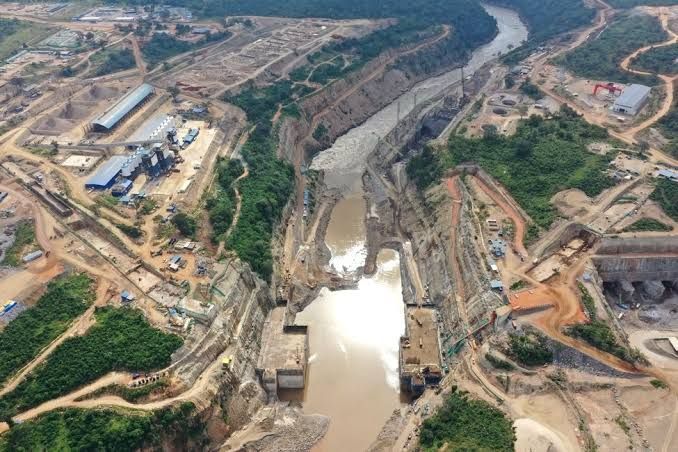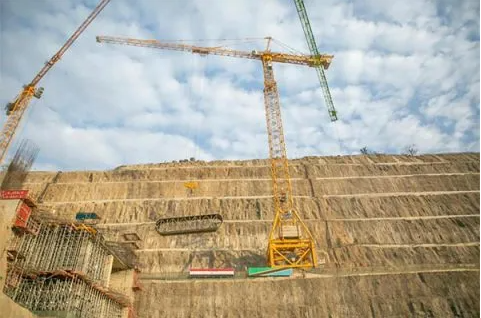
Julius Nyerere Hydropower Project in Tanzania has advanced to the next phase of development. This comes a short while after President Samia Suluhu Hassan presided over the opening of the diversion channel that would direct water into the dam.
The volume of water diverted into the reservoir, which is required for the generation of electricity, makes the diversion important.
Energy Minister January Makamba stated that the dam is 78% complete. He disclosed this while he was speaking on the construction site.
The largest hydropower project in the region’s opening of the diversion channel, according to Mr. Makamba, is an important step toward starting to fill the dam with water and produce electricity.
According to him, the dam, which will be used to generate water for the project, measures roughly 916 km2. Given its massive size, he continued, it will be more of a lake than a dam.
He claimed that the Egyptian contractors, Elsewedy Electric Ltd. and Arab Contractors, have already been paid Tsh 4.5 trillion ($1.92 billion) by the Tanzanian government.
President Samia’s opening of the diversion channel marks a huge milestone forward in the project’s implementation. The remaining step is to switch on the turbines so that power generation can begin later.
Project overview
Julius Nyerere Hydropower Station; the largest in the East African Community (EAC) is a US $2.9bn project being constructed across the Rufiji River in eastern Tanzania.
The station is expected to have an installed capacity of 2,115MW and will produce 5,920GWh of power annually. The power generated will be evacuated via a new 400kV high voltage power line to a substation where the power will be integrated into the national electricity grid.
The 134 metres (440 ft) arched, concrete dam is expected to create a reservoir lake, 100 kilometres (62 mi), in length, measuring 1,200 square kilometres (460 sq mi), with 34,000,000,000 cubic metres (1.2×1012 cu ft) of water.
The project is owned and will be managed by the government owned Tanzania Electric Supply Company (TANESCO). It is expected to enhance access to affordable electricity which will propel economic growth as well as attract investment in the country.
It will also transform the country through generation and supply of reliable electricity for both domestic and industrial use.
The government of Ethiopia is advising the Tanzanian government on the implementation of this project. Construction of the fourth largest power station in Africa is expected to be completed in 2022.
Controversy
The Julius Nyerere Hydropower Station project has received criticism from environmental experts because the location of the gorge is in the middle of the Selous Game Reserve World Heritage Site.
Conservationists are opposed to this project saying it threatens the endangered animal species in the area especially the black rhinoceros and elephants.
Also Read: Nairobi Expressway project timeline and all you need to know
Below is the project’s timeline and all you need to know.
Timeline
2017
In August, the Tanzanian government advertised for bids to construct this dam.
2018
Despite the underlined criticism of the project, after diplomatic negotiations between Tanzania’s President John Pombe Magufuli and Egypt’s President Sisi in October, the government awarded the design and construction contract for the power project to the Egyptian company Arab Contractors together with the Egyptian manufacturing company El Sewedy Electric, at the budgeted cost of US $2.9bn.
A new design for Stiegler’s Gorge Dam was unveiled. It was established that upon completion, this would be Africa’s largest dam by installed capacity (2,115MW).
2019
In February, the government handed the construction site over to the contractors. However, actual construction did not start until the summer of 2019 because the contractors needed several months to mobilize construction equipment.
In April, the government made an upfront payment of about US $309.6m, taking care of approximately 15% total cost of construction.
2020
As of June, the project was 40% complete.
2021
By January, the bypass tunnel for the dam site was functional and excavation of the 50m deep dam base was in progress. The three head-race tunnels, which will supply nine penstocks for the nine turbines, were under construction. The nine turbines are each to have a capacity of 235MW. Foundation for the power house was also in progress.
In April, Prime Minister Kassim Majaliwa announced that the Julius Nyerere Hydropower Station project was 45% complete and that once complete, it will be an avenue for Tanzania to get more revenue from increased clients both large factories as well as small users.
Aug 2021
Construction of Julius Nyerere Hydropower Station 45% complete
Construction of the Julius Nyerere Hydropower Station; the largest in the East African Community (EAC) has reached 45%.
Julius Nyerere Hydro-Power Project, Tanzania: Excavation of power water ways 74% complete
The excavation works of three Power Water Ways through which water will flow to help spin nine turbines at the Julius Nyerere Hydro-Power Project in Tanzania, along the Rufiji River, has reached 74 percent completion. This is according to the Project Manager, Eng. Said Kambanga, who also works with the Tanzania Electric Supply Company Limited (Tanesco).
Kambanga explained that the excavation of the Water Ways which will direct water to the powerhouse is an important stage in the project execution after the diversion of water from its ordinary route, followed by other important developments to support power generation.
The project manager affirmed that the excavation works are set to be completed by December this year, stressing that there are no foreseen setbacks to hinder the process. He also added that the construction of the Power House will be finalized around the same time that the tunneling works will be completed making way for the other stage of the project which is pouring concrete in both areas. This stage is expected to start in January next year.
Implementation of the entire project on track
Eng. Said Kambanga confirmed that everything with regard to the implementation of the entire flagship project was going on as planned. He said that together with his fellow patriotic experts, have been working day and night to ensure the East African Country’s goals of possessing a state of the art hydropower production facility in the continent and the first of its kind in Sub-Saharan Africa is realized within the stipulated time.
First turbine installed at Julius Nyerere Hydroelectric project in Tanzania
In mid-August, Egypt’s Minister of Housing, Utilities and Urban Communities Assem El-Gazzar announced that Egyptian consortium has begun installing the first turbine for the Julius Nyerere Hydroelectric Power Project (JNHPP).

The installed turbine is the first of nine, each with a capacity of 235MW, and the total hydropower dam’s capacity stands at 2,115MW.
Late Aug 2021
Julius Nyerere Hydroelectric project to deliver first MW in June 2022
The Julius Nyerere Hydroelectric project is set to deliver its first power in June 2022. The Tanzanian government made the announcement and said the decision follows the project’s progress.
Minister of Energy, accompanied by Assem Gazzer said the project is already 62.7% complete with current focus on installation of the turbines.
Aug 2021
First turbine installed at Julius Nyerere Hydroelectric project in Tanzania
The first turbine has been installed at the Julius Nyerere Hydroelectric project in Tanzania. Egypt’s Minister of Housing, Utilities and Urban Communities Assem El-Gazzar announced that the installation was witnessed by officials from the Tanzanian Ministry of Energy, the employer of the project.
Sep 2021
Julius Nyerere Hydroelectric Dam: 27 transformers installed to increase transmission
Tanzania has started the installation of 27 transformers at the construction site of Julius Nyerere Hydroelectric Power Plant (JNHPP). The transformers will be used to increase the transmission voltage of the electricity produced by the power plant from 15 kV to approximately 400 kV.
This was revealed by the projects Resident Engineer John Mageni from Tanroads Engineering Consultation Unit (TECU) during a recent official tour of the project’s site made by civil servants from the State House and the Ministry of Public Service Management and Good Governance.
According to Eng. Mageni the construction of the powerhouse, which has a length of 305 meters, a width of 60 meters, and a height of 80 meters is ongoing, and the foundation work for the construction of the Switchyard where the electricity produced at the JNHPP will be connected to the national grid has begun.
Other ongoing works
Eng. Mageni also mentioned other main ongoing works including the construction of the main dam which has a total length of 1,025 meters at crest level and the height of 131 meters, and the construction of three power waterways with an average of 550 meters length each. The power waterways will channel water to hydro turbines.
He explained that the Chinese company, Dongfang Electric Corporation, is going on with the assembly and installation of nine electromechanical equipment that will have the capacity to produce 235 Megawatts each. The equipment in question includes hydro-turbines, generators, excitation systems, and main inlet valves.
“Already six of this electromechanical equipment have arrived at the site and two of them have been installed, while others are in the preparations of being installed,” expounded the resident engineer.
The works also include the construction of a permanent bridge over the Rufiji River, which will be 250 meters high and 12 meters wide.